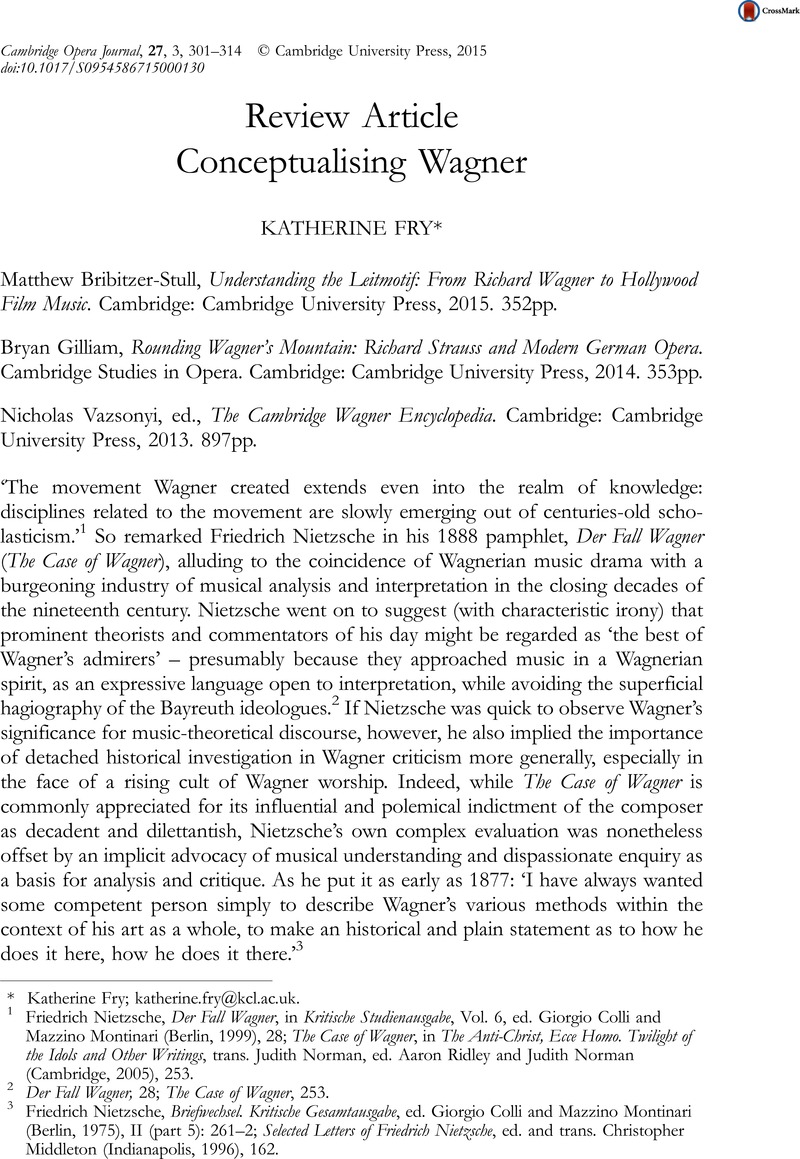No CrossRef data available.
Article contents
Conceptualising Wagner
Review products
Published online by Cambridge University Press: 12 November 2015
Abstract

- Type
- Review Articles
- Information
- Copyright
- © Cambridge University Press 2015
Footnotes
Katherine Fry; [email protected].
References
1 Nietzsche, Friedrich, Der Fall Wagner, in Kritische Studienausgabe, Vol. 6, ed. Giorgio Colli and Mazzino Montinari (Berlin, 1999), 28Google Scholar; The Case of Wagner, in The Anti-Christ, Ecce Homo. Twilight of the Idols and Other Writings, trans. Judith Norman, ed. Aaron Ridley and Judith Norman (Cambridge, 2005), 253.
2 Der Fall Wagner, 28; The Case of Wagner, 253.
3 Nietzsche, Friedrich, Briefwechsel. Kritische Gesamtausgabe, ed. Giorgio Colli and Mazzino Montinari (Berlin, 1975), II (part 5): 261–262Google Scholar; Selected Letters of Friedrich Nietzsche, ed. and trans. Christopher Middleton (Indianapolis, 1996), 162.
4 See, for example, Lorenz, Alfred, Das Geheimnis der Form bei Richard Wagner, 4 vols. (Berlin, 1924–33)Google Scholar; and Kurth, Ernst, Romantische Harmonik und ihre Krise in Wagner’s Tristan (Bern, 1920)Google Scholar.
5 Deathridge, John, ‘A Brief History of Wagner Research’, in The Wagner Handbook, ed. Ulrich Müller and Peter Wapnewski; English trans. ed. John Deathridge (Cambridge, MA, 1992), 202Google Scholar. See also Deathridge, , ‘Cataloguing Wagner’, Musical Times 124 (1983), 92–96CrossRefGoogle Scholar.
6 See Millington, Barry, ed., The Wagner Compendium: A Guide to Wagner’s Life and Music (London, 1992)Google Scholar; Müller and Wapnewski, The Wagner Handbook; Grey, Thomas S., ed., The Cambridge Companion to Wagner (Cambridge, 2008)CrossRefGoogle Scholar.
7 See, for example, the contributions to the recent special issue of Opera Quarterly on ‘Wagner and the Left’; Opera Quarterly 30/2–3 (2014).
8 See, for example, Eva Rieger’s entries on ‘Gender’ (148–50) and ‘Women’ (724–6); as well as Chris Walton’s essay on ‘Sexuality and Eroticism’ (531–4).
9 See David Huckvale, ‘Film Music’ (126–7) and Lutz Koepnick, ‘Wagner and New Media’ (655–8).
10 For a brief overview of the concept, see Whittall, Arnold, ‘Leitmotiv’, CWE, 245–249Google Scholar, and Thorau, Christian, ‘Leitmotiv Guides’, CWE, 249–251Google Scholar.
11 Newman, Ernest, The Wagner Operas (Princeton, 1989)Google Scholar; Cooke, Deryck, I Saw the World End: A Study of Wagner’s Ring (London, 1979)Google Scholar; Donington, Robert, Wagner’s Ring and its Symbols: The Music and the Myth (London, 1963)Google Scholar; Dahlhaus, Carl, Richard Wagner’s Music Dramas, trans. Mary Whittall (Cambridge, 1979)Google Scholar; Kirby, F. E., Wagner’s Themes: A Study in Musical Expression (Warren, MI, 2004)Google Scholar.
12 See Abbate, Carolyn and Parker, Roger, ‘Introduction: On Analyzing Opera’, in their Analyzing Opera: Verdi and Wagner (Berkeley, 1989)Google Scholar.
13 Abbate, Carolyn, Unsung Voices: Opera and Musical Narrative in the Nineteenth Century (Princeton, 1991), 168CrossRefGoogle Scholar.
14 See Grey, Thomas S., ‘wie ein roter Faden: On the Origins of the “leitmotif” as Critical Construct and Musical Practice’, in Music Theory in the Age of Romanticism, ed. Ian Bent (Cambridge, 1996), 187–210Google Scholar; Thorau, Christian, Semantisierte Sinnlichkeit: Studien zu Rezeption und Zeichenstruktur der Leitmotivtechnik Richard Wagners (Stuttgart, 2003)Google Scholar.
15 Adorno, Theodor W., In Search of Wagner, trans. Rodney Livingstone (London, 2005), 31Google Scholar.
16 For Wagner’s comments on leitmotivic analysis of the Ring, see Cosima Wagner’s Diaries: An Abridgement, ed. and trans. Geoffrey Skelton, Vol. 1. (New Haven, 1994), 435 (1 August 1881).
17 See, for example, Gilliam, Bryan, The Life of Richard Strauss (Cambridge, 1999)Google Scholar; idem, ed., Richard Strauss and his World (Princeton, 1992); idem, ed., Richard Strauss: New Perspectives on the Composer and his Work (Durham, NC, 1992); idem, ‘Ariadne, Daphne and the Problem of Verwandlung’, Cambridge Opera Journal 15 (2003), 67–81; idem, ‘Between Resignation and Hope: The Late Works of Richard Strauss’, in Late Thoughts: Reflections on Artists and Composers at Work, ed. Karen Painter and Thomas Crow (Los Angeles, 2006), 167–80.
18 See, for example, Youmans, Charles, Richard Strauss’s Orchestral Music and the German Intellectual Tradition: The Philosophical Roots of Musical Modernism (Bloomington, 2005)Google Scholar.


